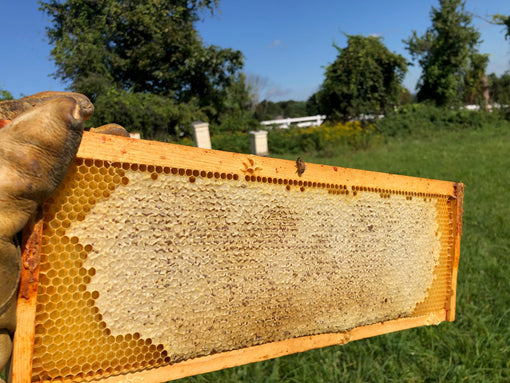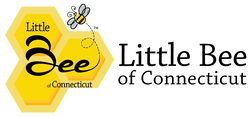
- Article published at:
- Article author: Web Dev
- Article tag: honey bees
- Article comments count: 0
At Little Bee of Connecticut, we harvest our honey twice a year. Once in mid-June and again in mid-September. We just completed our last harvest of the year this past weekend. I thought it would be the perfect time to show everyone how we get that golden goodness direct from the hives and straight to you.
Nectar gathering and ripening (Warning: Science content)
Producing honey starts with the forager bees collecting nectar from different floral sources. During this process, the bees generate the enzyme invertase which is then mixed with the nectar. Upon returning to the hive the foragers transfer the nectar to the house bees. They add more enzymes and place it in the honeycomb. The enzymes break down the sucrose in the nectar to glucose and fructose, a process known as “ripening” the honey. While this is occurring, the bees fan the nectar with their wings to reduce the moisture content. Once the bees detect that the nectar is fully ripened and the water content is low enough, they will cap the honey cells with beeswax. This protects the honey until the bees are ready to consume it by preventing it from reabsorbing moisture.
Ready to harvest
Inspecting frames & a fully capped frame
When it is harvest time, we begin by inspecting the honey frames looking for them to be completely capped. This is a critical step. Harvesting uncapped frames with too high of a water content can cause it to ferment.
When we find a fully capped frame, now we must get hundreds of bees off each one. We could use smoke to move them into the lower boxes. Personally, I don’t like this as it can result in ash from the smoker fuel staying on the honeycomb, which could give the honey a smoke taste. We simply shake the frame over the hive to remove most of them and brush the rest off.
Prepare to extract
To extract the honey from the frames we could just scrape all the honey and comb off the frame and let it drain out. If we did that, then next year the bees would need to rebuild all that comb before having a place to store the nectar. Honeybees produce wax by consuming the nectar and excreting it from their wax gland. This would result in a smaller harvest due to all the repurposed nectar for producing wax.
Uncapping the frame
We use the uncapping method. Scraping the frame with a “fork” to remove only surface wax covering the honey. This preserves the honeycomb on the frames which can then be used again for future honey harvests.
Spinning Frames
As each frame is uncapped, we load it into our extractor. When we first started beekeeping there were only a couple of hives, so we purchased a small 3 frame hand crank extractor. It suited its purpose at the time but as we continued to grow the number of hives, this became very laborious and sometimes hilarious process. Taking an entire day to extract 50 or more frames only 3 at a time, plus having to flip them over to do the other side. A few years ago, it was decided that an upgrade was needed. Now an 18 frame motorized extractor that does both sides at once makes quick work of the job.
The high-speed spinning generates centrifugal force that flings the honey from the frame to the wall of the extractor (See video below).
It then flows down and collects underneath. The uncapping process does leave flakes of beeswax in the honey. When the honey is drained, we pass it through a strainer to remove the wax pieces and THAT’S IT! (See video below) We do not filter our honey as this could remove the pollens that are contained with the honey. It is never heated either as that can deteriorate the natural enzymes and nutrients within.
Ready to go!!!
When all the honey is extracted and drained it remains in a sealed container overnight to allow entrapped air bubbles to rise out. The following day we jar and label so it’s ready for sale via our website or at craft shows (When they still happened. Thanks 2020).
The question we are most often asked about honey is if we see a difference between the spring and fall honey. Check out the picture below to see if you notice a difference.
On the left is honey from our Fall 2020 harvest and on the right is our Spring 2020 Harvest. Clearly a night and day difference. Right?! Why? Here in Connecticut it’s all due to the different nectar sources available each season. In the spring the bees forage on things like clover, dandelion, and flowering trees to name a few. This results in a lighter more floral tasting honey. During the late summer you have goldenrod, buckwheat, knotweed, and others. This produces a much darker and richer honey for our fall harvest. I think it has a slight taste of molasses to it.
Our fall honey is now available on our website. Be sure to pick up a jar before it’s all gone.
Thanks for reading our blog! I hope you found it informative and insightful.
Learn More

